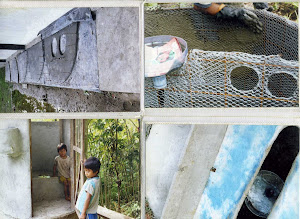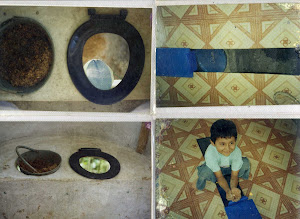(Scroll down for English)
En abril, hicimos un modelo económica y ecológicamente amigable de ArborLoo, dentro de un curso de capacitación del Cuerpo de Paz, en Tumbaco, en las afueras de Quito.
El ArborLoo es un tipo de sanitario ecológico ideado por Peter Morgan (Zimbabwe), en la cual se construye una casita liviana y portátil que se coloca sobre una serie de huecos poco profundos, donde luego se siembran árboles. Es aplicable solo en lugares con tierras relativamente secas y absorbentes. Uno de sus mayores ventajas es las heces se quedan encapsuladas en la tierra y nadie tiene que manejarlas (hasta que estén convertidas en deliciosas frutas en el árbol). (Vea los libros de Peter en www.ecosanres.org.)
Los más sobresalientes aspectos del nuevo modelo son:
- El techo es hecho de plástico PET cortado de botellas desechables. (Pondré más detalle sobre cómo se hace esto en otra entrada). Esto permite entrar más luz y aire, además de reducir su costo y su huella ecológica.
- Tiene un tubo de ventilación, hecho de botellas desechables de plástico PET (3 litros, 12 cm diámetro), que va desde la banca hasta arriba del techo, para desalojar posibles olores.
- La pared de privacidad es de plástico blanco, lo cual también permite pasar gran cantidad de luz.
- La puerta está hecha de cartones de TetraPak, abiertos y cosidos y luego grapados sobre un marco de madera. TetraPak es muy durable, muy abundante y poco reciclable (de forma convencional).
- Sus
dimensiones son 80 cm de ancho, 120 cm de largo, y 2 m de alto. La mitad
del largo es el piso y la otra mitad es la banca. La banca es de 38 cm
de alto. El hueco cilíndrico en la tierra es de 100 cm de profundo y 50
cm en diámetro.
- Una capa de vinil cubre el piso y la banca, para mayor elegancia y para facilitar su limpieza. También cubre la superficie interior de la banca, donde choca la orina.
- La madera es utilizada solo en el esqueleto, piso y banca, así reduciendo el peso de la casita y su contribución a la deforestación. (Se puede proteger la madera con aceite quemado de motores.)
- Como toda la estructura es liviana y podría ser llevada por el viento, es sujetada a la tierra por medio de una soga y dos estacas.
- Los usuarios deben agregar una taza de tierra seca, cenizas, etc. después de cada depósito.
Agradezgo mucho la ayuda de los voluntarios de Cuerpo de Paz, sus colaboradores locales y su coordinadora Eveliz.
- - -
A (largely recycled) New Model of ArborLoo
In Abril, we built an economically and ecologically friendly model of ArborLoo, within a training course on Ecological Sanitation for the Peace Corps, in Tumbaco, in the outskirts of Quito.
An ArborLoo is a type of ecological toilet that was thought up by Peter Morgan of Zimbabwe, in which a lightweight, portable outhouse is put over a series of shallow holes where trees are later planted. This is applicable only where the soil is relatively dry and absorbent. One of its greatest advantages is that the feces remain encapsulated in the earth and no one has to deal with them (until they are converted into delicious fruits on the tree). (See Peter's books on www.ecosanres.org.)
The details:
- The roof is made from PET plastic cut from disposable bottles. (I will post more detail on how to do this later.) This permits the entry of more light and air, in addition to reducing its cost and ecological footprint.
- A ventilation pipe is also made from disposable PET plastic bottles (3 liters, 12 cm diameter), that reaches from the bench to above the roof, to vent possible odors.
- The privacy walls are made of white plastic, which also lets lots of light in.
- The door is made from TetraPak cartons, opened out and sewn together, then stapled to a wooden frame. TetraPak is very durable, abundant, and does not lend itself very well to conventional recycling.
- Its dimensions are 80 cm wide, 120 cm long, and 2 m high. Half of the length is the floor and the other half is the bench. The bench is 38 cm high. The cylindrical hole in the ground is 100 cm deep and 50 cm diameter.
- Linoleum covers the floor and bench, for more elegance and to facilitate cleaning. There is also linoleum on the inner surface of the bench, to protect the wood from the urine.
- Wood is only used in the frame, floor and bench, thus reducing the weight of the outhouse and its contribution to deforestation. (The wood can be protected with used motor oil.)
- Since the structure is so light and could be blown around by the wind, it is tied down to the ground with a rope and two stakes.
- Users should add a cup of dry soil, ashes, etc. after each deposit.
Many thanks to the Peace Corps Volunteers, their local counterparts, and their coordinator Eveliz.













